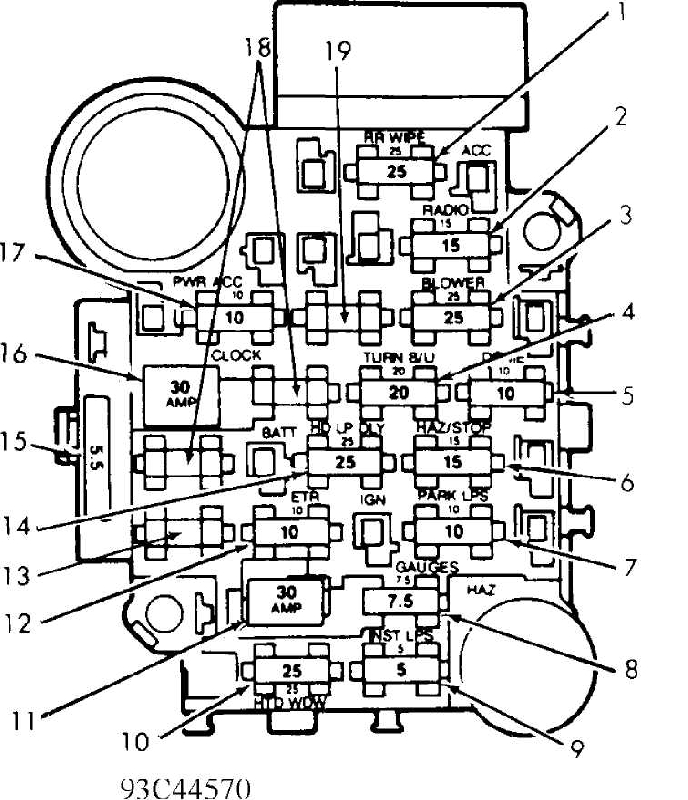FUSES & CIRCUIT BREAKERS
1988 Jeep Cherokee
Fuses & Circuit Breakers 1984-88 AMC/Jeep
Jeep; Cherokee, Wagoneer
IDENTIFICATION
FUSES & CIRCUIT BREAKERS
Fuse panel is located at the lower left side of dash on most

Fig. 1: Fuse Panel Identification Courtesy of American Motors Corp.
FUSE & CIRCUIT BREAKER IDENTIFICATION
1-25 Amp
Rear Washer/Wiper.
2-15 Amp
Radio, Cigarette Lighter.
3-25 Amp Blower Motor.
4-20 Amp
Turn Signal, Back-Up Lights, Rear Window Defogger Relay.
5-10 Amp
Dome Light, Courtesy Lights, Glove Box Light, Cargo Light, Radio Memory, Power Mirrors, Teltak Connector.
6-15 Amp
Hazard Warning System, Stoplights.
7-10 Amp
Parking Lights, Headlight Warning Chime/Buzzer, Instrument Panel Light Dimmer.
8-7.5 Amp
Gauges, Instrument Cluster, Seat Belt Warning, Headlight Delay, Chime Module, Overhead Console.
9-5 Amp
Instrument Panel Illumination.
10-25 Amp
Rear Window Defogger.
11 - 30 Amp (Circuit Breaker)
Power Door Locks, Power Seats, Trailer Towing Wiring Harness.
12 - 10 Amp
ETR Radio, Power Antenna.
13 - Not Used (1984-87); 7.5 Amp (1988)
Transmission Control Unit.
14-25 Amp
Headlight Delay, Horns, Security Alarm.
- 5.5 Amp (Circuit Breaker)
Front Wiper.
- 30 Amp (Circuit Breaker)
Power Windows.
17-10 Amp
Clock, Security Alarm (Ign) .
CAUTIONS & WARNINGS
REPLACING BLOWN FUSES
Before replacing a blown fuse, remove ignition key, turn off all lights and accessories to avoid damaging the electrical system. Be sure to use fuse with the correct indicated amperage rating. The use of an incorrect amperage rating fuse may result in a dangerous
electrical system overload. BATTERY WARNING
WARNING: When battery is disconnected, vehicles equipped with computers may lose memory data. When battery power is restored, driveability problems may exist on some vehicles. These vehicles may require a relearn procedure. See the COMPUTER RELEARN PROCEDURES article in GENERAL INFORMATION section.
ELECTROSTATIC DISCHARGE SENSITIVE (ESD) PARTS
WARNING: Many solid state electrical components can be damaged by
static electricity (ESD). Some will display a warning label, but many will not. Discharge personal static electricity by touching a metal ground point on the vehicle prior to servicing any ESD sensitive component.
HALOGEN BULBS
Halogen bulbs contain pressurized gas which may explode if overheated. DO NOT touch glass portion of bulb with bare hands. Eye protection should be worn when handling or working around halogen bulbs.
RADIATOR CAP
CAUTION: Always disconnect the fan motor when working near the
radiator fan. The fan is temperature controlled and could start at any time even when the ignition key is in the OFF position. DO NOT loosen or remove radiator cap when cooling system is hot.